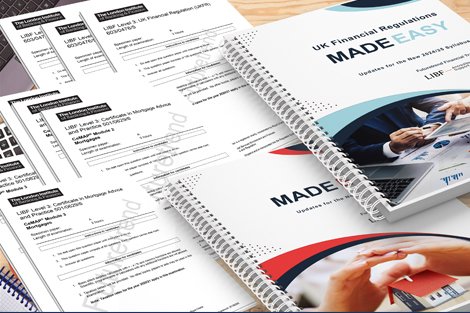A structured study plan gives you focus and confidence. It turns a large syllabus into manageable parts. With clear goals and regular review, you can fit CeMAP study around work and family life without feeling overwhelmed.
This guide explains the CeMAP exam structure, breaks down each module and its units, shows you how to allocate time by topic difficulty, and outlines a session‑based approach for study and review. You’ll discover how to mix learning methods, monitor progress, and use evidence‑based repetition techniques to maximise retention.
Understanding the CeMAP Exam & Syllabus
The Certificate in Mortgage Advice and Practice (CeMAP) is split into three separate exam papers: Module 1, Module 2 and Module 3.
Module 1 and Module 2 each contain 100 multiple‑choice questions, while Module 3 has 60 questions presented in six client scenarios of ten questions each. Each module is timed at 70 minutes and requires a 70 % pass mark.
Breaking the syllabus down by unit helps you target your revision and build confidence before each exam.
Breaking Down the CeMAP Syllabus by Module & Unit
Pro Tip: Always consult the latest LIBF syllabus PDF for any updates.
Module 1 – UK Financial Regulation & Products (UKFR)
2 Units
Unit 1: Introduction to Financial Services Environments and Products
- Overview of the UK financial services sector and product types
- Roles of banks, insurers and intermediaries
- Basic mechanics: savings, investments and insurance
Unit 2: UK Financial Services and Regulation
- Regulatory bodies: FCA and PRA objectives
- Key legislation: Financial Services and Markets Act; Senior Managers and Certification Regime
- Ethics, conduct rules and professional standards
Module 2 – Mortgages (MORT)
4 Units
Unit 3: Mortgage Law, Policy and Markets
- Consumer Credit Act and mortgage‑specific regulation
- Market overview: lender types, product distribution channels
Unit 4: Mortgage Applications
- Conducting a comprehensive factfind
- Affordability assessments and stress‑testing
Unit 5: Mortgage Payment Methods and Products
- Repayment vs interest‑only mortgages
- Specialist options: offset, retirement interest‑only, flexible mortgages
- Calculating APR and total cost of credit
Unit 6: Mortgage Arrears and Post‑Completion
- Common arrears triggers and lender procedures
- Protection products for post‑completion scenarios
Module 3 – Assessment of Mortgage Advice & Knowledge (ASSM)
1 Unit
Unit 7: Assessment of Mortgage Advice & Knowledge
- Six integrated client scenarios, ten questions each
- Synthesising regulation, product knowledge and factfind into a suitability report
- Post‑completion review and client communication
Allocating Study Time Based on Difficulty
Not all topics demand equal effort. Assign your total study time in rough proportions:
- High difficulty (mortgage calculations; regulatory framework) → 40 %
- Medium difficulty (product knowledge; factfind processes) → 35 %
- Lower difficulty (basic definitions; ethics) → 25 %
Common Pitfall: Under‑estimating calculation practice. Build in timed drills for speed and accuracy.
Flexible Study Sessions & Goals
A session‑based approach lets you slot study around life’s demands:
Session types:
- Morning commute session (30–45 mins)
- Evening session (1–1.5 hrs)
- Weekend deep‑dive (2–3 hrs)
Designing each session (1–2 hrs):
- Warm‑up (10 mins): quick recap of last session
- Core study (40–60 mins): focus on one unit or topic
- Practice & application (20–30 mins): questions or calculations
- Review & notes (10 mins): summarise and flag weak areas
Weekly plan:
- Schedule 8–12 sessions per week
- Reserve 1–2 catch‑up sessions for missed slots
- Include 2 sessions purely for spaced‑repetition review
Pro Tip: Colour‑code topics in your planner (e.g. red for calculations, blue for ethics) to ensure variety.
Session Based Repetition & Review
Spaced or distributed practice boosts long‑term recall by spreading sessions over time. Rather than fixed‑day reviews, assign four dedicated review sessions per topic:
- Session 1: Immediate review in next available study block
- Session 2: 1–2 sessions later for retrieval practice
- Session 3: 3–4 sessions later using mixed‑topic quizzes
- Session 4: 5–6 sessions later as a longer self‑test on weekends
Combine multiple units per review session to simulate exam conditions. Slot these reviews into lighter days or weekends as catch‑up blocks.
Pro Tip: Label sessions (e.g. “R1–Unit 4”, “R3–Calc”) and track score improvements to identify weak areas.
Mixing Up Your Learning Methods
Varied media improve engagement and retention:
- Textual study: official LIBF manuals and regulation guides
- Video tutorials: visual explanations of complex topics
- Practice questions: current mock papers and topic question banks
- Peer discussions: study groups or online forums
Common Pitfall: Relying on one medium. Regularly switch between reading, watching and doing.

Monitoring Progress & Adjusting Your Plan
Regular checks keep you on track:
- Weekly self‑assessment: mini‑quizzes under timed conditions
- Metrics to record: question accuracy, time per question, session completion
- Plan adjustments: re‑allocate sessions to topics with low scores
Recommended Resources & Support
- LIBF official syllabus & sample papers – essential for up‑to‑date exam content
- CeMAP revision courses from LIBF Accredited Learning and Support Providers
- Online forums (e.g. The Money Advice Service community; Reddit’s r)

Conclusion & Next Steps
A clear, session‑based study plan tailored to topic difficulty and regular review is the most efficient route to CeMAP success. By breaking the syllabus into units, allocating time wisely, and using evidence‑based repetition, you can fit study around your busy life without stress.
Enrol in a structured, accredited CeMAP revision course to access expert guidance, proven study templates and guaranteed accountability.